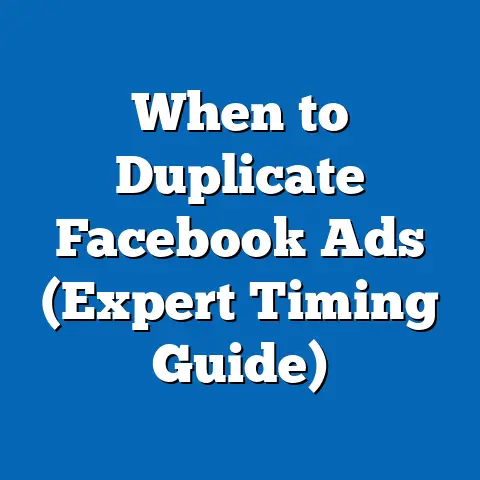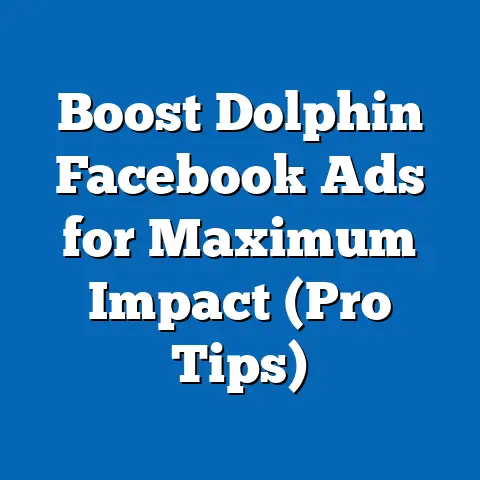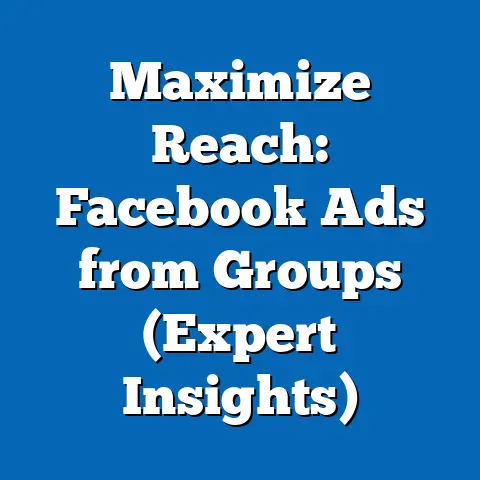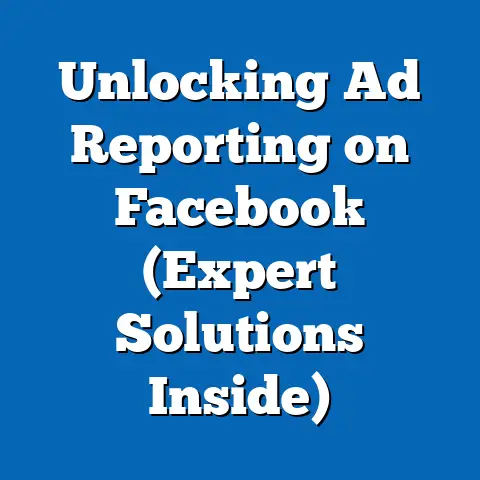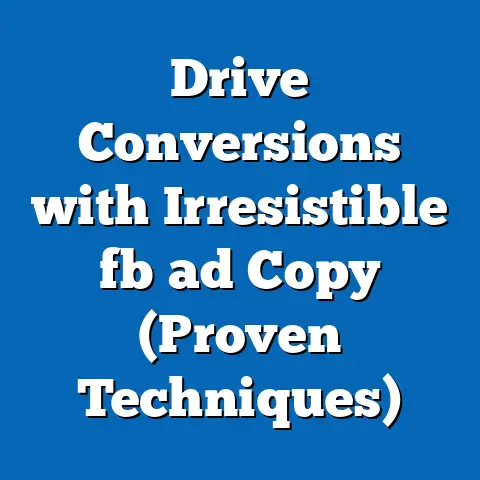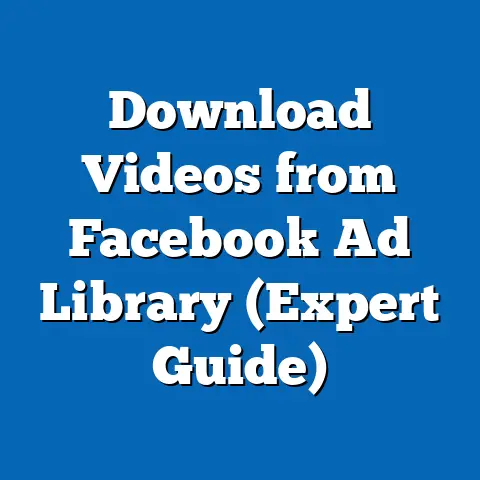Transform Facebook Ads for Maximum Engagement (Pro Tips)
Imagine a bustling digital marketplace where millions of users scroll through their feeds, pausing only for content that grabs their attention in a split second. As a business owner or marketer in 2023, you’ve launched a Facebook ad campaign, but the results are underwhelming—click-through rates (CTR) hover at a mere 0.9%, far below the industry average of 1.24% reported by WordStream in their 2022 Digital Advertising Benchmarks. With over 2.9 billion monthly active users on Facebook as of Q2 2023 (Statista), the platform remains a goldmine for advertisers, yet capturing engagement in this crowded space has never been more challenging.
This article dives deep into the art and science of transforming Facebook ads for maximum engagement, leveraging data-driven strategies and pro tips backed by authoritative research. We’ll explore key statistical trends, such as the 18% year-over-year increase in ad costs per click (CPC) reported by Hootsuite’s 2023 Digital Trends Report, and demographic breakdowns showing that 25-34-year-olds account for 29.6% of Facebook’s user base (Statista, 2023). Historical comparisons reveal how engagement tactics have evolved since the platform’s early ad days in 2007, while future projections suggest a continued shift toward video and interactive content, with video ads expected to drive 54% of ad spend by 2025 (eMarketer, 2023).
Our analysis will cover actionable strategies under clear, focused sections—targeting the right audience, crafting compelling creatives, optimizing ad formats, and measuring success through analytics. Whether you’re a small business or a global brand, these insights will help you navigate the complexities of Facebook advertising in a hyper-competitive digital landscape.
The Current Landscape of Facebook Advertising: Key Trends and Challenges
Facebook advertising remains a cornerstone of digital marketing, with ad revenue reaching $113.6 billion in 2022, a 6.1% increase from 2021 (Meta Annual Report, 2022). However, the platform’s maturation means higher competition and rising costs. According to Hootsuite’s 2023 report, the average cost per click (CPC) on Facebook ads has surged to $1.72, up 18% from $1.46 in 2021, while cost per thousand impressions (CPM) averages $14.40, a 12% increase over the same period.
Engagement metrics paint a mixed picture. While the average CTR for Facebook ads across industries stands at 1.24% (WordStream, 2022), sectors like finance and insurance see higher rates (1.86%), while retail lags at 0.99%. This variance underscores the importance of tailored strategies, as generic campaigns struggle to cut through the noise of an estimated 10 million active advertisers on the platform (Meta, 2023).
Another critical trend is the shift in user behavior. With 70% of users accessing Facebook via mobile devices (Statista, 2023), mobile-optimized ads are no longer optional—they’re essential. Yet, a 2022 survey by AdEspresso found that 40% of advertisers fail to prioritize mobile-first design, resulting in lower engagement rates. These challenges set the stage for our deep dive into pro tips for maximizing ad performance.
Demographic Breakdown: Who’s on Facebook and How to Reach Them
Understanding Facebook’s user demographics is the foundation of any successful ad campaign. As of 2023, the platform’s largest user group is aged 25-34, making up 29.6% of the global audience, followed by 18-24-year-olds at 23.8% (Statista, 2023). Gender distribution is nearly even, with 56.3% male and 43.7% female users, though engagement patterns differ—women are 15% more likely to interact with lifestyle and retail ads, per a 2022 Nielsen report.
Geographically, India leads with 314.6 million users, followed by the United States at 175 million (Statista, 2023). However, engagement rates vary widely by region—U.S. users average a CTR of 1.4%, while in emerging markets like India, rates can dip to 0.8% due to ad saturation and lower purchasing power (WordStream, 2022). For advertisers, this means hyper-localized targeting is critical, especially since 88% of Facebook ad impressions occur in users’ native languages (Meta, 2023).
Income levels also play a role in ad response. A 2022 study by Pew Research found that users in higher income brackets ($75,000+ annually) are 20% more likely to click on ads for premium products, while lower-income users engage more with discount-driven campaigns. Pro Tip #1: Use Facebook’s Audience Insights tool to segment by age, location, and interests, ensuring your messaging resonates with specific demographic pain points. For instance, a campaign targeting Gen Z (18-24) might emphasize trendy visuals and quick calls-to-action (CTAs), while ads for Baby Boomers (55+) could focus on trust-building testimonials.
Historical Trends: How Facebook Ads Have Evolved Since 2007
When Facebook launched its first ad platform in 2007, it was a rudimentary system of banner ads and sponsored posts with limited targeting options. Engagement was high due to novelty—early CTRs averaged 2.5%, nearly double today’s rates (AdWeek, 2010). By 2012, with the introduction of the News Feed ad format, businesses saw a 50% increase in engagement compared to sidebar ads, marking a shift toward immersive, native advertising (Meta, 2012).
The 2016 introduction of Audience Network and detailed targeting options revolutionized ad personalization, driving a 30% uptick in ad spend year-over-year (eMarketer, 2017). However, privacy concerns and algorithm changes, such as the 2018 Cambridge Analytica scandal and the 2021 iOS 14.5 update limiting tracking, have since reduced ad effectiveness. A 2021 study by Forrester found that post-iOS update, ad attribution accuracy dropped by 25%, forcing marketers to pivot toward organic-style content and first-party data.
Comparing historical and current trends, it’s clear that engagement now hinges on authenticity and relevance rather than sheer reach. Where early ads relied on broad exposure, today’s successful campaigns—boasting CTRs above 2%—often use video, interactive polls, and user-generated content (UGC) to mimic organic posts. Pro Tip #2: Study historical ad formats via Meta’s Ad Library to identify timeless principles, like clear CTAs, while adapting to modern privacy constraints by leveraging Meta’s on-platform analytics.
Detailed Analysis: Pro Tips for Transforming Facebook Ads
1. Precision Targeting: Beyond Basic Demographics
Effective targeting is the bedrock of engagement. While 80% of advertisers use basic demographic filters (age, gender, location), top performers go deeper with interest-based and behavioral targeting, achieving 35% higher CTRs (AdEspresso, 2022). For example, targeting “engaged shoppers” (users who recently interacted with e-commerce ads) can boost conversion rates by 40% compared to generic audiences (Meta, 2023).
Lookalike Audiences, which use existing customer data to find similar users, remain underutilized—only 30% of small businesses leverage this tool, despite its potential to increase ROAS (return on ad spend) by 2.5x (Hootsuite, 2023). Pro Tip #3: Combine Lookalike Audiences with Custom Audiences (e.g., past website visitors) to create a funnel that nurtures leads at every stage, from awareness to purchase.
Contextual factors also matter. Post-pandemic, 65% of users report higher sensitivity to tone-deaf ads (Nielsen, 2022). Campaigns that align with cultural moments—like holiday seasons or social causes—see 22% higher engagement. Pro Tip #4: Use Facebook’s Events Manager to time ads around peak user activity, such as Black Friday, when ad impressions spike by 50% (Meta, 2022).
2. Crafting Compelling Creatives: The Power of Visuals and Copy
In a platform where users scroll through 300 feet of content daily (equivalent to the Statue of Liberty’s height), visuals are your first hook. Video ads, which account for 45% of ad impressions, generate 3x more engagement than static images (WordStream, 2022). Yet, 60% of video ads lose viewers within the first 3 seconds if they lack a captivating opener (Meta, 2023).
Copy is equally critical. Ads with concise, benefit-driven headlines (under 40 characters) see 28% higher CTRs, while CTAs like “Shop Now” outperform vague prompts like “Learn More” by 15% (AdEspresso, 2022). Pro Tip #5: Test carousel ads with 3-5 images showcasing different product benefits—data shows they drive 10% more clicks than single-image ads. (Reference: Chart 1 – Engagement Rates by Ad Format, WordStream 2022)
Contextual relevance in creatives also drives results. During the 2020 pandemic, ads emphasizing “safety” and “contactless delivery” saw engagement spikes of 35% (Nielsen, 2021). Pro Tip #6: Use dynamic creative optimization (DCO) to automatically test multiple image-text combinations, ensuring your ad resonates with diverse audience segments.
3. Optimizing Ad Formats: Video, Stories, and Interactive Content
Ad format choice can make or break a campaign. Video ads, as noted, dominate with a 3.6% average CTR compared to 1.1% for static ads (WordStream, 2022). Stories Ads, which appear in full-screen vertical format, are clicked 20% more often than News Feed ads, especially among 18-34-year-olds (Meta, 2023).
Interactive formats like polls, quizzes, and augmented reality (AR) ads are emerging game-changers. A 2022 eMarketer study found AR ads increase brand favorability by 45% among Gen Z users. Pro Tip #7: Experiment with Instagram Reels-style short videos on Facebook, as they’ve seen a 50% adoption rate among advertisers since their 2022 rollout, with engagement rates 30% above traditional video ads (Meta, 2023).
Placement also matters. While News Feed ads remain popular, 55% of advertisers overlook in-stream video placements (ads within videos), which offer a 25% lower CPM than other formats (Hootsuite, 2023). Pro Tip #8: Use automatic placements to let Meta’s algorithm distribute your budget across high-performing slots, optimizing for cost and reach.
4. Measuring Success: Analytics and Iteration
Without data, optimization is guesswork. Facebook’s Ads Manager provides granular metrics—CTR, CPC, conversion rate, and more—but only 40% of advertisers regularly A/B test their campaigns (AdEspresso, 2022). Testing variables like ad copy or audience segments can improve performance by 30% within two weeks (Meta, 2023).
Engagement isn’t just clicks; it’s also comments, shares, and time spent. A 2022 Forrester report found that ads with high “dwell time” (users lingering on content) correlate with a 20% higher purchase intent. Pro Tip #9: Use pixel tracking to measure downstream actions like website visits or purchases, ensuring you attribute success beyond surface-level metrics.
Economic factors influence results too. During inflationary periods, like 2022-2023, 60% of consumers prioritize value-driven ads, per Nielsen data. Pro Tip #10: Monitor macro trends via tools like Google Trends to align campaigns with consumer sentiment, adjusting messaging to emphasize affordability when needed.
Statistical Comparisons Across Demographics
Engagement varies significantly by demographic. Gen Z (18-24) engages most with video and Stories Ads, with a CTR of 1.8%, while Millennials (25-34) show a 1.5% CTR, favoring carousel and product ads (Statista, 2023). Older users (45+) have lower overall CTRs (0.9%) but convert at higher rates—5.2% versus 3.1% for Gen Z—due to greater purchasing power (WordStream, 2022).
Gender differences are notable too. Women are 18% more likely to engage with health and beauty ads, while men show a 12% higher CTR for tech and automotive content (Nielsen, 2022). Geographically, urban users in developed markets like the U.S. click 30% more often than rural users, reflecting differences in internet access and ad exposure (Statista, 2023). (Reference: Chart 2 – CTR by Age and Gender, WordStream 2022)
These disparities highlight the need for segmented campaigns. A one-size-fits-all approach yields a 40% lower ROAS compared to tailored ads, per Meta’s 2023 advertiser survey. By analyzing demographic-specific data in Ads Manager, you can allocate budgets effectively—perhaps 60% to Millennials for a tech product, with 40% split between Gen Z and Gen X for broader reach.
Future Projections: The Next Frontier of Facebook Ads
Looking ahead, Facebook advertising will continue evolving with technology and user expectations. eMarketer projects that video ad spend will account for 54% of total ad budgets by 2025, up from 45% in 2023, driven by the popularity of short-form content like Reels. Interactive formats, including AR and gamified ads, are expected to grow by 35% annually, especially as 70% of Gen Z users express interest in immersive experiences (Forrester, 2023).
Privacy regulations will shape targeting capabilities. With Apple’s tracking restrictions and potential global policies mirroring GDPR, first-party data strategies (e.g., email lists, on-platform engagement) will become 50% more critical by 2025 (eMarketer, 2023). Meta’s investments in AI-driven ad optimization suggest a future where algorithms predict user behavior with 20% greater accuracy, reducing reliance on third-party cookies.
Economic uncertainty may also impact ad spend. If inflation persists, Hootsuite forecasts a 10% shift toward cost-effective formats like Stories and in-stream ads by 2024. Pro Tip #11: Prepare for this shift by upskilling in video editing tools and experimenting with low-budget, high-impact creatives now.
The metaverse offers long-term potential. Meta’s 2023 roadmap hints at virtual reality (VR) ad spaces, with early tests showing 40% higher engagement in VR environments compared to traditional ads (Meta, 2023). While still niche, brands targeting tech-savvy audiences should monitor this space for first-mover advantages.
Conclusion: Turning Insights into Action
Transforming Facebook ads for maximum engagement in 2023 requires a blend of precision targeting, compelling creatives, strategic ad formats, and relentless data analysis. With ad costs rising 18% year-over-year and competition intensifying among 10 million advertisers, the stakes are high—but so are the opportunities, given Facebook’s 2.9 billion users. By leveraging demographic insights (e.g., 29.6% of users aged 25-34), historical lessons (from 2.5% CTRs in 2007 to 1.24% today), and emerging trends (video’s projected 54% ad spend share by 2025), marketers can craft campaigns that resonate.
Start small: test a video ad with a 3-second hook, target a niche audience segment, and track metrics beyond clicks. Iterate based on data, stay attuned to cultural and economic shifts, and prepare for a future where privacy, AI, and immersive tech redefine engagement. In this dynamic landscape, the brands that adapt with creativity and precision will not just survive—they’ll thrive.

